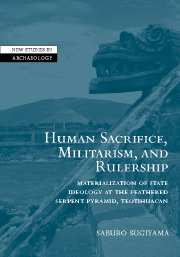 Human Sacrifice, Militarism, and Rulership
Human Sacrifice, Militarism, and Rulership Book contents
- Frontmatter
- Contents
- List of figures
- List of tables
- Acknowledgments
- 1 Introduction: cognition of state symbols and polity
- 2 Background: data and ideation
- 3 The Ciudadela and the city layout
- 4 Architecture and sculpture
- 5 Burials
- 6 Offerings
- 7 Overview: sacrificial and elite burials
- 8 Conclusion: the Feathered Serpent Pyramid as symbol of sacrifice, militarism, and rulership
- Notes
- References
- Index
3 - The Ciudadela and the city layout
Published online by Cambridge University Press: 22 September 2009
- Frontmatter
- Contents
- List of figures
- List of tables
- Acknowledgments
- 1 Introduction: cognition of state symbols and polity
- 2 Background: data and ideation
- 3 The Ciudadela and the city layout
- 4 Architecture and sculpture
- 5 Burials
- 6 Offerings
- 7 Overview: sacrificial and elite burials
- 8 Conclusion: the Feathered Serpent Pyramid as symbol of sacrifice, militarism, and rulership
- Notes
- References
- Index
Summary
I have suggested that major public architectural complexes in Teotihuacan probably had specific ritual meanings and functions within city-wide contexts. If a master plan for the city layout existed, meanings attached to the FSP would have been an integral part of the sacred geography expressed by the whole city. I believe that finding such a master plan and the contents of the sacred geography will help us understand the symbolism of the FSP.
In fact, instances exist around the world in which an ancient city's monuments and public buildings functioned as meaningful parts of the sacred city. Such structures were used mostly as ritual spaces or administrative offices, legitimizing sacred authority and the political power of the state. For example, celestial archetypes, symbolic centripetality, and other kinds of cosmo-magical principles were a fundamental part of ancient Chinese city planning (Wheatley 1971). Monuments and important official buildings of governors and their associates – the interpreters of Heaven's messages – were arranged spatially according to cosmologically codified significance. Ethnohistorical records document that the Cuzco quadripartition also rendered the capital a microcosm of the empire, as well as a metaphor for the Inca universe. Spatial dual division of Cuzco reflected patterns of social, economic, political, and religious organization, particularly in association with specific lineages (or ayllus) that extended into spatial organization of provinces (Zuidema 1983).
- Type
- Chapter
- Information
- Human Sacrifice, Militarism, and RulershipMaterialization of State Ideology at the Feathered Serpent Pyramid, Teotihuacan, pp. 38 - 52Publisher: Cambridge University PressPrint publication year: 2005
